Playtesting B-17 Flying Fortress Leader
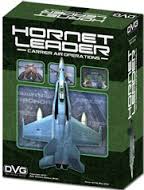 Until recently, Dan Verssen’s “Leader” game line has concentrated on various air war subjects. Given that my shelves are primarily filled with fantasy novels or books about pre 10th century eras I didn’t find them initially intriguing no matter my growing interest in solitaire board games, but Marco Arnaudo’s enthusiastic review of Hornet Leader won me over.
Until recently, Dan Verssen’s “Leader” game line has concentrated on various air war subjects. Given that my shelves are primarily filled with fantasy novels or books about pre 10th century eras I didn’t find them initially intriguing no matter my growing interest in solitaire board games, but Marco Arnaudo’s enthusiastic review of Hornet Leader won me over.
Even after I snagged a copy I didn’t take to Hornet Leader immediately, though. There were so many different armaments and so many different planes that I remarked to my friend Dean Brown that I felt like I was playing “Armament Leader” because I had to spend so much time choosing which kinds of bombs to put on my aircraft. I gather that happens to some players. I decided it wasn’t really for me, but for people who really liked knowing minute details about planes and bombs, and traded it away, but then, talking with Dean, I got to wondering if I’d really given it a fair shot. I decided to trade for a new copy last winter. After I played again and took more time with it I was hooked, and enjoyed several campaigns from December to March. And that left me in good shape to understand what a Leader game was all about, probably a good thing for a playtester for the upcoming B-17 Flying Fortress Leader game…
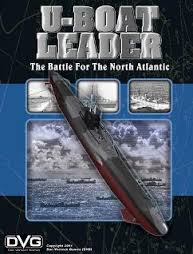 …Except that I didn’t have much interest in bombers. As an ancient history guy, I really didn’t have much interest in World War II, although I’d been curious about German submarine warfare ever since watching Das Boot during its American theatrical release in the ‘80s. DVG hit my sweet spot with a product that combined my interest in solitaire games and U-boats with U-Boat Leader, which is how I met Dean Brown in the first place. I was quite impressed with his add-ons and modifications to U-Boat Leader that he posted about on Board Game Geek, and we struck up a friendship over the course of our exchanges. When he told me he was developing a new leader game, I happily signed on board. I might not have held much initial enthusiasm in World War II bombers, but I was pretty certain Dean would design a good game. And besides, he needed some help.
…Except that I didn’t have much interest in bombers. As an ancient history guy, I really didn’t have much interest in World War II, although I’d been curious about German submarine warfare ever since watching Das Boot during its American theatrical release in the ‘80s. DVG hit my sweet spot with a product that combined my interest in solitaire games and U-boats with U-Boat Leader, which is how I met Dean Brown in the first place. I was quite impressed with his add-ons and modifications to U-Boat Leader that he posted about on Board Game Geek, and we struck up a friendship over the course of our exchanges. When he told me he was developing a new leader game, I happily signed on board. I might not have held much initial enthusiasm in World War II bombers, but I was pretty certain Dean would design a good game. And besides, he needed some help.
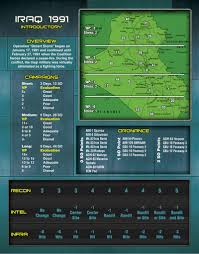 In previous air games from the Leader series players choose among several campaigns then determine that campaign’s length (short, medium, long, usually about 3, 6, or 9 days) and choose pilots. Each campaign – say, the ’91 Iraq War – has certain requirements, for instance how many pilots you have, how skilled they are, which targets are close, near, or long range, and how many and what sorts of weapons your planes can carry. (Click to enlarge the campaign card to the left for a more detailed example.) Each pilot has six different skill levels, ranging from newbie to ace, and as they fly missions, their abilities (like coolness under fire, air-to-air modifier, and air-to-ground modifier) improve. Not all pilots improve in the same way or at the same speed, though, and each has different strengths and weaknesses. Moreover, you start each campaign with several pilots at different levels of ability – so many at newbie, so many at green, a few veterans, and maybe an ace, along with the levels between.
In previous air games from the Leader series players choose among several campaigns then determine that campaign’s length (short, medium, long, usually about 3, 6, or 9 days) and choose pilots. Each campaign – say, the ’91 Iraq War – has certain requirements, for instance how many pilots you have, how skilled they are, which targets are close, near, or long range, and how many and what sorts of weapons your planes can carry. (Click to enlarge the campaign card to the left for a more detailed example.) Each pilot has six different skill levels, ranging from newbie to ace, and as they fly missions, their abilities (like coolness under fire, air-to-air modifier, and air-to-ground modifier) improve. Not all pilots improve in the same way or at the same speed, though, and each has different strengths and weaknesses. Moreover, you start each campaign with several pilots at different levels of ability – so many at newbie, so many at green, a few veterans, and maybe an ace, along with the levels between.
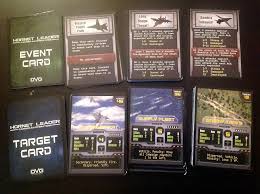 Each campaign consists of the drawing of multiple targets over multiple missions, which are printed on cards. Normally several mission cards are drawn before each flight and you choose the one you wish, although some present you with situations that must be addressed immediately, and others continue to have an effect on game play until the card’s target is eliminated. On the way to the target, you draw from another deck to see if there are any unexpected events, and you randomly determine the target’s defenses as well, be they extra enemy planes or missile installations.
Each campaign consists of the drawing of multiple targets over multiple missions, which are printed on cards. Normally several mission cards are drawn before each flight and you choose the one you wish, although some present you with situations that must be addressed immediately, and others continue to have an effect on game play until the card’s target is eliminated. On the way to the target, you draw from another deck to see if there are any unexpected events, and you randomly determine the target’s defenses as well, be they extra enemy planes or missile installations.
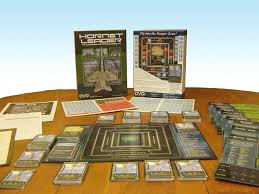 There’s even more than that, but I’ll cut to the chase. The result is a lovely tactical puzzle/brain burner for every mission, and there’s an added bonus in that careful management and play of your pilots sees them rise in skill. A narrative develops and if you’re not careful (frequently I’m not) you find yourself setting up for the next mission and then playing it, and then telling yourself you’ll just set up for the next to play for tomorrow and then playing it… Moreover, there’s just a lot of variety in the number of campaigns, for each has different situations further changed by permitted plane and armament types, and challenges, not to mention the endless randomization of those die roll results. You can see the campaign cards in the right of this accompanying image, and even a handful more are available online.
There’s even more than that, but I’ll cut to the chase. The result is a lovely tactical puzzle/brain burner for every mission, and there’s an added bonus in that careful management and play of your pilots sees them rise in skill. A narrative develops and if you’re not careful (frequently I’m not) you find yourself setting up for the next mission and then playing it, and then telling yourself you’ll just set up for the next to play for tomorrow and then playing it… Moreover, there’s just a lot of variety in the number of campaigns, for each has different situations further changed by permitted plane and armament types, and challenges, not to mention the endless randomization of those die roll results. You can see the campaign cards in the right of this accompanying image, and even a handful more are available online.
I’m not entirely sure how long a campaign of Hornet Leader or B-17 Flying Fortress Leader takes a reasonable person, since I frequently binge played, but I do know that a single mission takes about a half hour or less once you know the system. If you have a spot where you can leave the game set up, and you have better self control, you can look forward to a week or two of engaging challenge every evening until the campaign concludes.
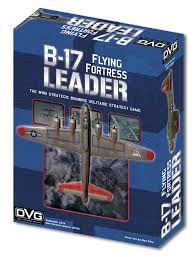 B-17 Leader has some overall similarities to Hornet Leader but it’s very different – and equally compelling, at the least. No matter what B-17 campaign you select, you’ll always have to contend with the Luftwaffe. Whether you’re playing the oil campaign (where you’re attempting to cripple the Reich’s war efforts by bombing their oil holdings and plants) or whether you’re waging a campaign against the German V-2 sites (amongst many other campaigns – these, though, are the two I primarily play tested), you’ll still need to spend some time contending with Luftwaffe airfields or aircraft plants. If you focus solely on the campaign targets, the Luftwaffe will continue to hammer you, and new squadrons will continue to be placed on the map. Trying to decide just how often you need to worry about the aircraft plants versus how many campaign-specific targets you want to take on is just one of many player challenges.
B-17 Leader has some overall similarities to Hornet Leader but it’s very different – and equally compelling, at the least. No matter what B-17 campaign you select, you’ll always have to contend with the Luftwaffe. Whether you’re playing the oil campaign (where you’re attempting to cripple the Reich’s war efforts by bombing their oil holdings and plants) or whether you’re waging a campaign against the German V-2 sites (amongst many other campaigns – these, though, are the two I primarily play tested), you’ll still need to spend some time contending with Luftwaffe airfields or aircraft plants. If you focus solely on the campaign targets, the Luftwaffe will continue to hammer you, and new squadrons will continue to be placed on the map. Trying to decide just how often you need to worry about the aircraft plants versus how many campaign-specific targets you want to take on is just one of many player challenges.
The campaigns in B-17 Leader have an even greater variety than those in the previous games – every one of them feels quite different. For instance, the oil campaign doesn’t play exactly like the V-2 campaign, where target cards continue to launch missiles at you every week – if those missiles hit, they lower the player’s operational points that are used to resupply. There are other differences as well, partly dependent upon what year of the war the campaigns are set in. I think players will be pleasantly astonished by the diversity. You’re basically getting a box stuffed with a whole slew of different games that use the same engine. It’s impressive.
Every time you send your bombers and escorts out, the Luftwaffe sends different kinds of randomly drawn planes against them, each with different statistics, and depending upon who the Luftwaffe commander is, they may use different tactics as well. Some Luftwaffe commanders are more likely to send out additional squadrons, too, adding to the variety and chaos. And the Luftwaffe commander may well be recalled or replaced every month or so, randomizing the situation even further.
While each “plane card” offers a range of skills from newbie up to ace (like other DVG air leader games) and has piloting skills (air-to-air, air-to-ground, and speed) the cards represent not individual planes/pilots, but entire air groups. Both bomber and fighter groups are available; all types used by the allies in the European theatre (and for “what if scenarios” Dean even included at least one that was used only in the Pacific). Each group can be upgraded by the further expenditure of operational points – you can purchase a commander, and different ones come with different tactics. For instance, a fighter group commander might come with Fast, or Out of the Sun as a tactic, giving you a bonus when you have to fight off the Luftwaffe.
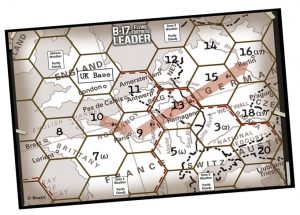 Additional upgrades can be purchased with operational points, too, including reinforcement for a bomber’s “chin,” chaff that can be dropped to help against shrapnel, and other goodies. Of course operational points also can be used to pay for more powerful bombs or reconnaissance flights. A successful recon flight can provide a huge bonus against a target, although the recon planes can be shot down.
Additional upgrades can be purchased with operational points, too, including reinforcement for a bomber’s “chin,” chaff that can be dropped to help against shrapnel, and other goodies. Of course operational points also can be used to pay for more powerful bombs or reconnaissance flights. A successful recon flight can provide a huge bonus against a target, although the recon planes can be shot down.
There’s a tremendous amount of fun to be had with this game, and it was a pleasure to play. You have to pick squadrons and manage those operation points every week. Do you have enough points to buy a recon plane, or special bombs for that hard-to-crack target, or to reinforce your plane or add a new group or get a good commander? Should you have gone for that better protected target or that one over there under stormy skies and get more victory points if you destroy it? Once you get over target, did you bring enough armaments to destroy it? Should you have packed an incendiary?
There are countless other decisions, and of course the other conditions and enemy movements run by the system: Will the weather over the best target hold? Will any of the Luftwaffe squads be diverted by that mission you flew to the phony target? What event card will you pull on your way to the target or back? How will the Luftwaffe commander react? If he’s replaced, will the new commander order his pilots to use more deadly tactics? At the end of the week, how many new Luftwaffe squads will be sent against you on the western front? And if you’re attacked in flight, what kind of fighters will you face, and which bombers will they try to down? Will you lose any of your groups to flak over the target?
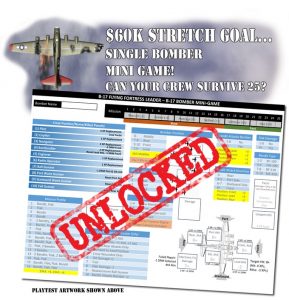 It’s agonizing and spellbinding and a heck of a lot more fun than I would ever have expected. I can hardly wait to see what the finished product looks like, and look forward to playing it this winter, always my prime game time.
It’s agonizing and spellbinding and a heck of a lot more fun than I would ever have expected. I can hardly wait to see what the finished product looks like, and look forward to playing it this winter, always my prime game time.
Dean came up with a sort of mini-game to help test out a couple of features and even that was so enjoyable that I lobbied hard for him to expand it and include it in the base game. I think he was already leaning that way himself, though – which is part of the reason you’ll find it in the box when the game’s released later this year. (The other reason is that the game kept smashing its Kickstarter goals and an additional reward or two was needed!)
In short, this is a grand game, worth every penny. And as an added bonus, it got me interested in the era and the efforts of those heroic plane crews.
B-17: Flying Fortress Leader can be pre-ordered from NWS Online, along with numerous DVG titles and other fine games. A preview video created by the game designer, Dean Brown, can be viewed here. It demonstrates the near final game play with prototype components only. The final game will have a mounted board and much finer pieces.
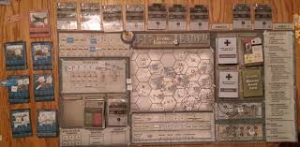
6 Comments